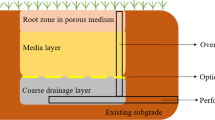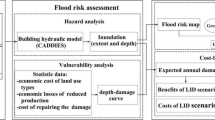Abstract
Low-impact development (LID) technologies, such as bioretention areas, rooftop rainwater harvesting, and xeriscaping can control stormwater runoff, supply non-potable water, and landscape open space. This study examines a hybrid system (HS) that combines LID technologies with a centralized water system to lessen the burden on a conventional system (CS). CS is defined as the stormwater collection and water supply infrastructure, and the conventional landscaping choices in the City of Atlanta. The study scope is limited to five single-family residential zones (SFZs), classified R-1 through R-5, and four multi-family residential zones (MFZs), classified RG-2 through RG-5. Population density increases from 0.4 (R-1) to 62.2 (RG-5) persons per 1,000 m2. We performed a life cycle assessment (LCA) comparison of CS and HS using TRACI 2.1 to simulate impacts on the ecosystem, human health, and natural resources.We quantified the impact of freshwater consumption using the freshwater ecosystem impact (FEI) indicator. Test results indicate that HS has a higher LCA single score than CS in zones with a low population density; however, the difference becomes negligible as population density increases. Incorporating LID in SFZs and MFZs can reduce potable water use by an average of 50% and 25%, respectively; however, water savings are negligible in zones with high population density (i.e., RG-5) due to the diminished surface area per capita available for LID technologies. The results demonstrate that LID technologies effectively reduce outdoor water demand and therefore would be a good choice to decrease the water consumption impact in the City of Atlanta.

Similar content being viewed by others
References
Goldstein R, Smith W. Water and Sustainability (Volume 4): U.S. Electricity Consumption for Water Supply & Treatment—The Next Half Century. No 1006787 Palo Alto: Electric Power Research Institute (EPRI) I, 2002
Lundie S, Peters G M, Beavis P C. Life cycle assessment for sustainable metropolitan water systems planning. Environmental Science & Technology, 2004, 38(13): 3465–3473
Racoviceanu A I, Karney B W. Life-cycle perspective on residential water conservation strategies. Journal of Infrastructure Systems, 2010, 16(1): 40–49
Environmental Protection Agency. Combined sewer overflows demographics. 2009. Available online at http://cfpub.epa.gov/npdes/cso/demo.cfm. (March 23, 2012)
Roseen R M, Ballestero T P, Houle J J, Briggs J F, Houle K M. Water quality and hydrologic performance of a porous asphalt pavement as a stormwater treatment strategy in a cold climate. Journal of Environmental Engineering, 2012, 138(1): 81–89
LeFevre G H, Novak P J, Hozalski R M. Quantification of petroleum hydrocabon residual and biodegradation functional genes in rain garden field sites. In: Proceedings of International Low Impact Development San Francisco. American Society of Civil Engineering (ASCE), 2010, 1379–1386
Ahiablame L M, Engel B A, Chaubey I. Effectiveness of low impact development practices: literature review and suggestions for future research. Water, Air, and Soil Pollution, 2012, 223(7): 4253–4273
Davis A P. Green engineering principles promote low-impact development. Environmental Science & Technology, 2005, 39(16): 338A–344A
Ahn J H, Grant S B, Surbeck C Q, DiGiacomo P M, Nezlin N P, Jiang S. Coastal water quality impact of stormwater runoff from an urban watershed in southern California. Environmental Science & Technology, 2005, 39(16): 5940–5953
Hatt B E, Fletcher T D, Deletic A. Hydraulic and pollutant removal performance of fine media stormwater filtration systems. Environmental Science & Technology, 2008, 42(7): 2535–2541
Ahammed F, Hewa G A, Argue J R. Applying multi-criteria decision analysis to select WSUD and LID technologies. Water Science & Technology: Water Supply, 2012, 12(6): 844–853
Okeil A. A holistic approach to energy efficient building forms. Energy and Building, 2010, 42(9): 1437–1444
Hatt B E, Deletic A, Fletcher T D. Integrated treatment and recycling of stormwater: a review of Australian practice. Journal of Environmental Management, 2006, 79(1): 102–113
Stephens D B, Miller M, Moore S J, Umstot T, Salvato D J. Decentralized groundwater recharge systems using roofwater and stormwater runoff. Journal of the American Water Resources Association, 2012, 48(1): 134–135
Che-Ani A I, Shaari N, Sairi A, Zain M F M, Tahir M M. Rainwater harvesting as an alternative water supply in the future. European Journal of Scientific Research, 2009, 34(1): 132–140
Taylor S, Apt D, Candaele R. Potential maximum use of harvested stormwater volume at a site level. In: Proceedings of World Environmental and Water Resources Congress 2011: Bearing knowlege for sustainabily Palm Springs. American Society of Civil and Engineers (ASCE), 2011, 457–466
Eroksuz E, Rahman A. Rainwater tanks in multi-unit buildings: a case study for three Australian cities. Resources, Conservation and Recycling, 2010, 54(12): 1449–1452
Farreny R, Gabarrell X, Rieradevall J. Cost-efficiency of rainwater harvesting strategies in dense Mediterranean neighbourhoods. Resources, Conservation and Recycling, 2011, 55(7): 686–694
Angrill S, Farreny R, Gasol C M, Gabarrell X, Viñolas B, Josa A, Rieradevall J. Environmental analysis of rainwater harvesting infrastructures in diffuse and compact urban models of Mediterranean climate. International Journal of Life Cycle Assessment, 2012, 17(1): 25–42
Spatari S, Yu Z, Montalto F A. Life cycle implications of urban green infrastructure. Environmental Pollution, 2011, 159(8–9): 2174–2179
De Sousa M R C, Montalto F A, Spatari S. Using life cycle assessment to evaluate green and grey combined sewer overflow control strategies. Journal of Industrial Ecology, 2012, 16(6): 901–913
Wang R, Eckelman M J, Zimmerman J B. Consequential environmental and economic life cycle assessment of green and gray stormwater infrastructures for combined sewer systems. Environmental Science & Technology, 2013, 47(19): 11189–11198
Jeong H, Minne E, Crittenden J. Life cycle assessment of the City of Atlanta, Georgia’s centralized water system. International Journal of Life Cycle Assessment, 2015, 20(6): 880–891
Flynn K M, Traver R G. Green infrastructure life cycle assessment: a bio-infiltration case study. Ecological Engineering, 2013, 55: 9–22
Angrill S, Farreny R, Gasol C, Gabarrell X, Viñolas B, Josa A, Rieradevall J. Environmental analysis of rainwater harvesting infrastructures in diffuse and compact urban models of Mediterranean climate. International Journal of Life Cycle Assessment, 2012, 17(1): 25–42
Smetana S M, Crittenden J C. Sustainable plants in urban parks: A life cycle analysis of traditional and alternative lawns in Georgia, USA. Landscape and Urban Planning, 2014, 122: 140–151
City of Atlanta. Zoning Maps. Geographical Information Systems, 2013, Available at: http://gis.atlantaga.gov/gishome/
Department of Planning and Community Development. 2011 Comprehensive Development Plan. Atlanta: City of Atlanta, 2011
National Oceanic Atmostpheric Administration (NOAA). Advanced Hydrologic Prediction Service (AHPS). National Weather Service. 2010. Available online at: http://water.weather.gov/precip/ (December 5 2013)
ARC. Georgia Stormwater Management Manual—Volume 2 Technical Handbook. Commission A R, 2001
Mockus V. Part 6300 Hydrology National Engineering Handbook— Chapter 10 Estimation of direct runoff storm rainfall. 210-VI-NEH. Washington, DC: U.S. Department of Agriculture, 2004
Linsley R K, Paulhus J L, Kohler M A. Hydrology for Engineers. Colorado: McGraw-Hill,1982
AECOM. Water supply and water conservation management plan. Atlanta: Metropolitan North Georgia Water Planning District, 2009
Hanemann W M. Determinants of urban water use, In: Baumann D D, Boland J J, Hanemann W M, eds. Urban water demand management and planning. Colorado: Mc Graw-Hill, 1998, 31–75
Schelich J, Hillenbrand T. Determinants of residential water demand in Germany. Ecological Economics, 2009, 68(6): 1756–1769
Gleick P H, Haaz D, Henges-Jeck C, Srinivasan V, Wollf G, Cushing K K, Mann A. Waste Not, Want Not: The potential for urban water conservation in California. ISBN No. 1–893790–09–6. Oakland: Pacific Institute, 2003
Amon D, Crigler A, Eng W, Green B, Green M, Heying M. Guidelines for estimating unmetered landscaping water use. PNNL-19498. Washington, DC: U.S. Department of Energy, 2010
Center for Watershed Protection. Coastal stormwater Supplement to the Georgia Stormwater Management Manual. Ellicot City, MD: Georgia Environmental Protection Divison, 2009
Herngren L, Goonetilleke A, Ayoko G A. Understanding heavy metal and suspended solids relationships in urban stormwater using simulated rainfall. Journal of Environmental Management, 2005, 76 (2): 149–158
Sovocool K A, Morgan M, Bennett D. An in-depth investigation of Xeriscape as a water conservation measure. Journal-American Water Works Association, 2006, 98(2): 82–93
Hilaire R S, Arnold M A, Wilkerson D C, Devitt D A, Hurd B H, Lesikar B J, Lohr V I, Martin C A, McDonald G V, Morris R L, Pittenger D R, Shaw D A, Zoldoske D F. Efficient water use in residential urban landscapes. HortScience, 2008, 43(7): 2081–2092
U.S. Environmental Protection Agency. Stormwater—Technology Fact Sheet, Bioretention. EPA 832-F-99–012. Washington, DC: U. S. Environmental Protection Agency, 1999
Fewtrell L, Kay D. Microbial quality of rainwater supplies in developed countries: a review. Urban Water Journal, 2007, 4(4): 253–260
Doyle K C, Peter S. Effect of first flush on storage-reliability-yield of rainwater harvesting. Journal of Water, Sanitation and Hygiene for Development, 2013, 2(1): 1–9
Inter N A C H I. InterNACHI's estimated life expectancy chart. Available online athttp://www.srnhomes.com/pdf/National%20Association%20of%20Home%20Inspectors%20-%20Life_Expectancy.pdf. (April 10, 2015)
Curran M A. Studying the effect on system preference by varying coproduct allocation in creating life-cycle inventory. Environmental Science & Technology, 2007, 41(20): 7145–7151
Bare J. Tool for the reduction and assessment of chemical and other environmental impacts (TRACI)-User's Manual. S-106637-CP-2–0. Washington DC: U.S. Environmental Protection Agency, 2012
Gloria T P, Lippiatt B C, Cooper J. Life cycle impact assessment weights to support environmentally preferable purchasing in the United States. Environmental Science & Technology, 2007, 41(21): 7551–7557
Muñoz I, Milà-i-Canals L, Fernández-Alba A R. Life cycle assessment of water supply plans in Mediterranean Spain. Journal of Industrial Ecology, 2010, 14(6): 902–918
Milài Canals L, Chenoweth J, Chapagain A, Orr S, Antón A, Clift R. Assessing freshwater use impacts in LCA: Part I—Inventory modelling and characterisation factors for the main impact pathways. International Journal of Life Cycle Assessment, 2009, 14(1): 28–42
Sun G, McNulty S G, Moore Myers J A, Cohen E C. Impacts of multiple stresses on water demand and supply across the Southeastern United States1. JAWRA Journal of the American Water Resources Association, 2008, 44(6): 1441–1457
Alcamo J, Döll P, Henrichs T, Kaspar F, Lehner B, Rösch T, Siebert S. Global estimates of water withdrawals and availability under current and future “business-as-usual” conditions. Hydrological Sciences Journal, 2003, 48(3): 339–348
Frischknecht R, Jungbluth N, Althaus H J, Doka G, Dones R, Heck T, Hellweg S, Hischier R, Nemecek T, Rebitzer G, Spielmann M. The ecoinvent database: overview and methodological framework. International Journal of Life Cycle Assessment, 2004, 10(1): 3–9
Weidema B P, Wesnæs M S. Data quality management for life cycle inventories-an example of using data quality indicators. Journal of Cleaner Production, 1996, 4(3–4): 167–174
Author information
Authors and Affiliations
Corresponding author
Rights and permissions
About this article
Cite this article
Jeong, H., Broesicke, O.A., Drew, B. et al. Life cycle assessment of low impact development technologies combined with conventional centralized water systems for the City of Atlanta, Georgia. Front. Environ. Sci. Eng. 10, 1 (2016). https://doi.org/10.1007/s11783-016-0851-0
Received:
Revised:
Accepted:
Published:
DOI: https://doi.org/10.1007/s11783-016-0851-0




